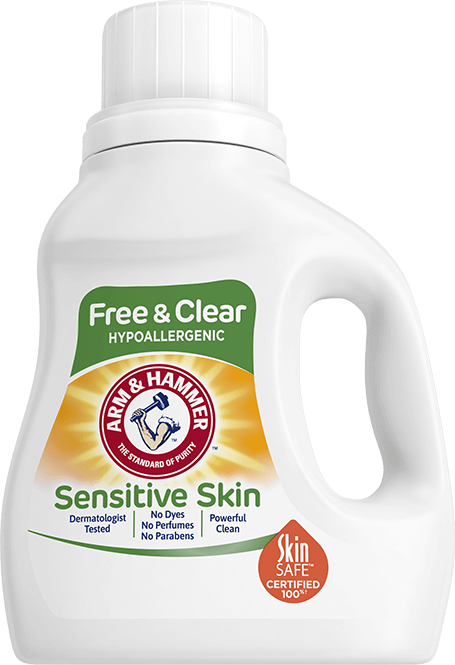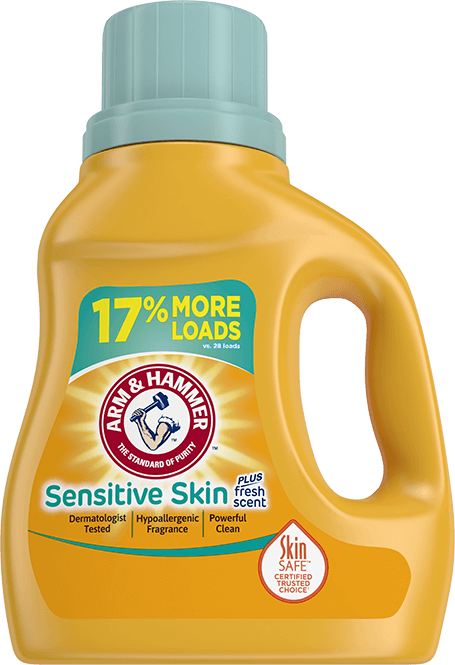Steps for Washing Sheets and How Often You Should Wash Them

There’s nothing better than unveiling your freshly washed sheets and climbing under the covers to snuggle up before bed – if only they could stay clean and fresh forever!
Here are some tips for how to wash sheets and extend their freshness, plus how often you should change your sheets so you can enjoy this feeling without having to do laundry every day.
How Often Should You Wash Your Sheets?
A good rule of thumb is to wash your sheets on a weekly basis. If you do not sleep on your mattress every day, you might be able to extend that timing to once every two weeks. However, you probably shouldn’t go much longer.
As yucky as it seems, dust mites, bacteria and other things you cannot see accumulate on your sheets over time, even when you’re not sleeping in them. Plus, you or your kids may have spilled something in bed. If you have pets, their smell may permeate your sheets. Lastly, your sheets may become a hotbed for germs when you or a family member are cooped up in bed with an illness.
So, washing and changing your sheets weekly is key to helping you and your kids settle down for a good night’s sleep!
What Water Temperature Should You Use to Wash Sheets?
Generally speaking, you want to wash your sheets using the temperature recommended on the laundry care label. Your sheets will likely need to be washed in Warm or Cold water, unless they are white and cotton, in which case you can wash in hot For dark colored sheets, you may choose warm, but cold water will help limit fading (and help save you money on your energy bill!).
While sheets are meant to be cozy, they can also become a little unkempt over time. Sheets are exposed to natural body odors, sweat stains, dead skin cells and other things you surely want to get rid of when you wash. Hot water is recommended to help deal with any lingering germs for clean and refreshed sheets!
In any case, check the manufacturer’s label and know when to use cold vs. hot water cycles.
What Wash Cycle Should You Use to Wash Sheets
For most sheets, you want to use a normal wash cycle (unless your washer has a dedicated Bedding or Sheets cycle), although certain natural fibers such as linen or silk may need a delicate cycle. You might also consider using the Heavy Duty cycle to really power out stains on your sheets or adding an Extra Rinse to help wash away any remaining detergent residue.
No matter what setting you choose, be sure not to overload your washing machine.
Can You Wash Sheets with Blankets and Other Laundry?

Wash your sheets separately from blankets and other items since they need space to move around inside the washer to get clean and in the dryer to dry evenly.
If you’re trying to be efficient, you might consider washing your towels and sheets together in the same load. But if you have many sheets (plus something like a duvet or comforter), it’s probably better to run them on their own cycle. If you have microfiber sheets, do not wash them with your towels as the microfibers tend to attract and retain lint from the towels.
How Do You Wash White Sheets?
White sheets may look dingy or yellowed over time because of body oils, sweat, and detergent or fabric softener residue. To help white sheets stay crisp and bright, add chlorine or oxygen bleach to your cycle or choose a detergent that contains bleach to get the best results.
For a convenient all-in-one solution to washing white sheets, try a detergent like ARM & HAMMER™ Plus OxiClean™ Stain Fighters. The color-safe, non-chlorine bleach and enzyme stain fighters help keep white sheets white and help restore brightness to sheets that have yellowed.
Or, add ½ cup Super Washing Soda Detergent Booster with your detergent to the washer drum before adding your sheets and starting the wash cycle. It is 100 percent fragrance- and phosphate-free and improves liquid laundry detergent performance by up to 15 percent*.
If your white sheets have gotten super dingy, it may be time to strip them. Use Super Washing Soda in your laundry stripping recipe when you’re trying to get your sheets super clean and remove any built-up residue.
*For mustard and blood stains vs. leading value detergent alone
Steps for How to Wash Sheets
Now that you know about the wash setting for sheets and how often to wash them, you’re ready to put the tips into action. Follow these steps for how to wash your sheets to get them looking extra clean again.
1. Check the Label
Always consult the fabric care label before washing sheets. It will determine the water temperature and cycle to use, depending on the material.
2. Pre-Treat Stains
If your fabric allows, apply a small amount of liquid laundry detergent directly to any stains. Accidents happen, and these stains may come from a glass of wine in bed, your kids dribbling ice cream during a late-night movie screening, Rover’s muddy paws, or a myriad of other reasons. Regardless, if you can, pre-treat those stains before putting your sheets in the wash!
3. Consider Using a Laundry Scent Booster
Laundry scent boosters can help extend the fragrance of your sheets with a long-lasting scent after washing. Don’t you like holding sheets up to your nose and smelling that ‘just-washed’ freshness when you first jump into bed? If so, try ARM & HAMMER™ Laundry Scent Boosters. Choose from a variety of exciting fragrances like Purifying Waters, Maui Sunset, Clean Meadow, and Tropical Paradise.
4. Add Detergent and Insert Sheets
Wash your sheets separately from other bedding, like duvets or comforters, and towels to help avoid pilling or excess lint. First, add your detergent to the drum. Or, if you have a high-efficiency (HE) washing machine, add it to the dispenser drawer. Next, evenly distribute the sheets to avoid tangling.
As far as detergent goes, choose one that fights stains, smells great, and fits any other needs you might have, like if you or another family member has sensitive skin. If you or your family has sensitive skin, you’ll want to make sure to use a detergent that’s free of dyes and perfumes, like ARM & HAMMER Sensitive Skin Free & Clear, which received a 100% rating from SkinSAFE!
5. Choose the Right Wash Temperature and Cycle
Follow the proper wash temperature and cycle settings according to your sheets’ fabric care label. A warm, normal cycle likely works for your cotton, polyester (but not microfiber) or linen sheets. Cold and delicate cycles may be needed for bamboo, silk or linen sheets. Read on for recommendations on which water temperatures and cycles to use for different types of sheets!
6. Dry Sheets in Dryer or Hang them Out to Dry
Use a tumble dry setting on low heat for your sheets, unless otherwise recommended by the care label. Avoid keeping your sheets in too long or drying at a high temperature. Silk or satin sheets may need to hang dry, or you can use a no-heat cycle if your dryer has one.
7. Fold Your Sheets and Store Them in a Cool Space

Once you pull your sheets out of the dryer, you can place them back on your bed. Or, if you changed sheets and want to store these for later use, make sure to fold and stack them before stashing them in a cool, dry area like a linen closet or blanket chest.
What Types of Sheets Do you Own?
Bed sheets can be made of different materials that may have separate washing instructions, according to the manufacturer’s label. Always check so you know what type of sheets you have, so you’ll know best how to care for them. Here are some common types of sheets and some pros and cons for each.
How to Wash Cotton Sheets
Cotton is one of the most common materials when it comes to sheets. Cotton sheets are long-lasting and can be budget-friendly or lush and luxurious. They also come in different forms, including Egyptian cotton and more.
However, cotton sheets can be more prone to wrinkles and can shrink, especially if you don’t follow the care instructions. Typically, you want to wash cotton sheets on a warm-water setting, but always follow the instructions on the manufacturer’s label. Some cotton sheets like percale—which refers to the weaving pattern used to make the sheet—may have different washing instructions.
How to Wash Bamboo Sheets
Like cotton sheets, bamboo sheets are durable and breathable while also being hypoallergenic and a good choice for people with sensitive skin. That said, bamboo sheets can be more expensive and may actually be rayon—a synthetic material—instead of pure bamboo fibers.
To help keep bamboo sheets soft and avoid shrinking, wash on a gentle or delicate setting or follow the directions on the label.
How to Wash Microfiber or Polyester Sheets
Polyester sheets are inexpensive and made using synthetic materials. Microfiber sheets involve finely woven polyester. It has a tighter weave, making it harder for dust mites to enter and is thus a strong hypoallergenic choice. They also tend to be wrinkle-free.
Note that polyester and microfiber sheets may attract lint and pet hair. It’s best to avoid washing microfiber sheets with towels, as you may get lint on the towels. You should wash most polyester and microfiber sheets in cold water, but the label will provide guidance.
How to Wash Silk and Satin Sheets

Silk and satin sheets look and feel soft and insulating, so they help regulate temperature for the chillier seasons when you really want to snuggle under the covers while also staying cool in hot weather! These sheets are more delicate and are among the most expensive types of bedding.
Both silk and satin sheets are occasionally made from blended materials. For those reasons, it’s extremely important to follow the directions on the label. You might also consider washing these sheets by hand or pre-treating them ahead of time, if recommended.
What Type of Detergent Should You Use to Wash Sheets?
When it comes to detergent, you want to use one that works gently, but effectively. Try some of the following ARM & HAMMER™ detergents to get those sheets in tip-top shape:
- If you, your kids or spouse have sensitive skin, choose a hypoallergenic laundry detergent, like the SkinSAFE-certified ARM & HAMMER™ Free & Clear.
- For your baby’s crib sheets and bedding, try ARM & HAMMER™ Baby Hypoallergenic Liquid Laundry Detergent for Newborns and Infants.
- We already touched on washing white sheets, but you should know the ARM & HAMMER™ Plus OxiClean™ Stain Fighters regimen is color-safe, so you can use on your kiddos’ superhero-themed sheets whenever the need arises!
- If you or your partner have night sweats or your sheets have some funky odors, try ARM & HAMMER™ Plus OxiClean™ Odor Blasters to power them out
Whether you are washing your own sheets or doing laundry for a family, ARM & HAMMER™ has ample options to choose from. Remember to follow the manufacturer’s instructions and consider adding Super Washing Soda Detergent Booster and laundry scent boosters to get those sheets extra clean and smelling fresh when you climb into bed.
How Do You Soften Sheets?
You may be wondering how to get your sheets soft so you and your kids can feel extra comfy climbing into bed. In this case, you might use a detergent with fabric softener, like ARM & HAMMER™ Plus a Touch of Softener Liquid Laundry Detergent. You might also use dryer sheets or practice laundry stripping to remove residue and restore softness to your sheets.
ARM & HAMMER™ Products Help You Refresh Your Bedding
Whether you need scent boosters to keep your sheets smelling fresh or a detergent that works gently on sensitive skin, ARM & HAMMER™ laundry products help clean and deodorize your sheets, regardless of their material. Turn to ARM & HAMMER™ when you need to wash your sheets and give them a refresh before settling in for a deep and peaceful slumber!
Learn How to Wash Other Household Items
- 5 Tips for How to Wash Sports Jerseys
- 5 Tips for How to Wash Swimsuits & Make Them Last
- How to Wash Sweaters by Hand or in the Washing Machine

